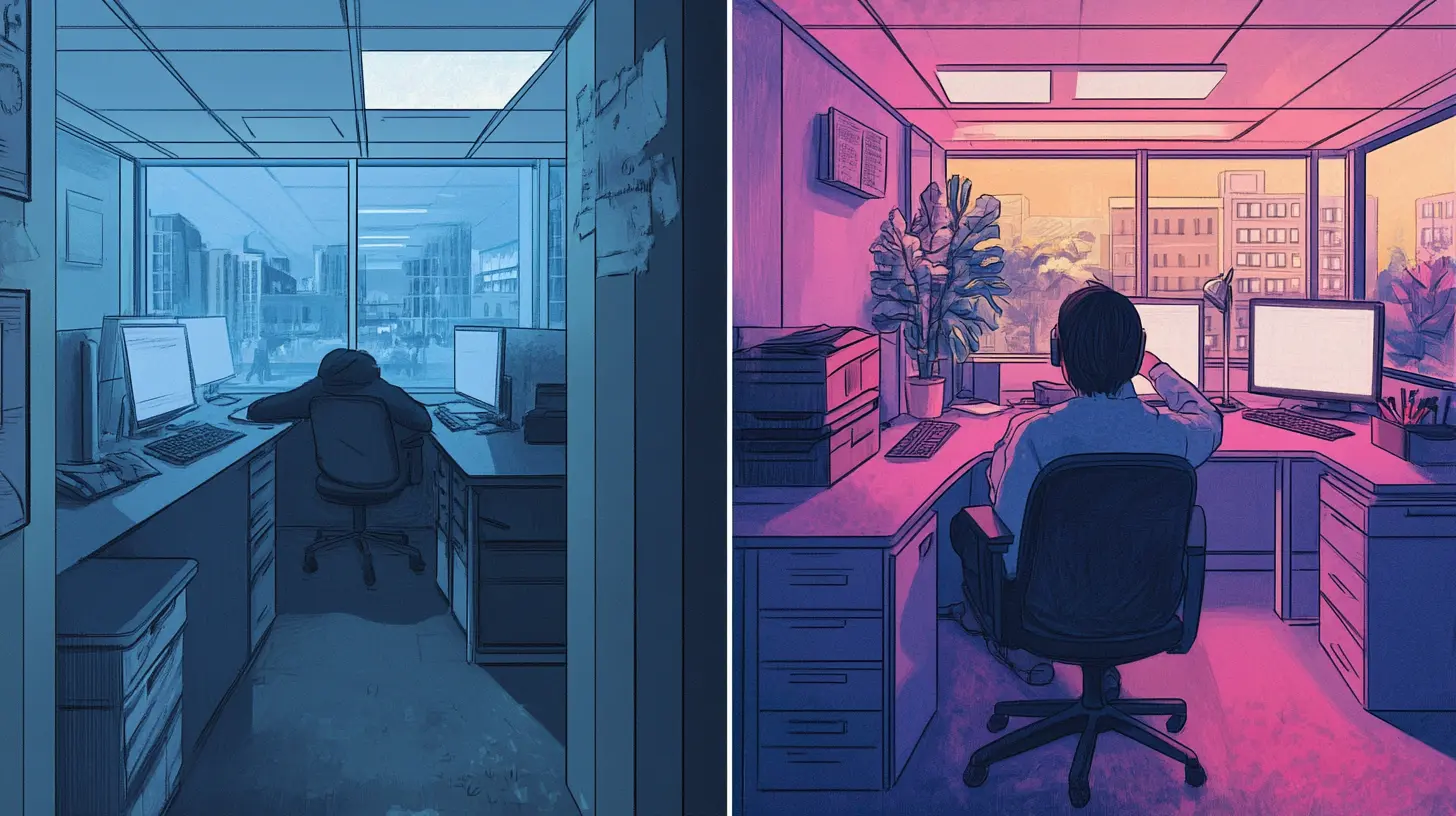The alarm sounds. Another Monday. Another week of meetings, deadlines, and counting down to Friday.
For many of us, work has become something we endure rather than experience—a sentence to be served rather than a canvas for creation.
But what if this feeling isn’t inevitable? What if work could be something we move toward rather than escape from?
The Quiet Crisis of Modern Work#
We’re living through a silent epidemic: the normalization of work as suffering.
- “Thank God it’s Friday.”
- “Living for the weekend.”
- “Another day, another dollar.”
These phrases have become so common we barely notice them anymore. But they reveal a troubling truth—we’ve accepted that work should feel like a slow-motion prison sentence, punctuated by brief paroles of weekend freedom.
When we surrender one-third of our lives to something that feels like a sentence, we begin losing ourselves.
The False Binary of Work and Life#

Our language betrays our mindset. We talk about “work-life balance” as if work exists outside of life—as if the hours we spend working somehow don’t count as living.
This false binary creates an impossible equation. If work is separate from life, then every hour given to work is necessarily stolen from “real living.” No wonder it feels like a sentence.
What if work isn’t opposed to life, but rather one expression of it? What if we could dissolve this boundary and see work as one of many canvases for creation, connection, and meaning?
What Makes Work Feel Like a Sentence?#
Before we can reimagine work, we need to understand what gives it that prison-like quality in the first place.
The Hallmarks of “Sentence-Like” Work#
Disconnection from Purpose
When we can't see how our daily tasks connect to anything meaningful, work becomes mechanical—a series of motions performed for a paycheck rather than a purpose.Lack of Agency
The feeling of powerlessness—having little say in what you do, how you do it, or when you do it—creates the same psychological effect as confinement.Identity Misalignment
Having to suppress your authentic self to fit into workplace culture creates a painful split between who you are and who you pretend to be for eight hours a day.Time Scarcity
When work consumes so much time and energy that little remains for what matters to you, the sense of lost life compounds daily.
For newer generations, these dynamics can be particularly acute. Coming of age in a time of always-on digital connectivity and economic uncertainty has created new pressures:
- The expectation to be available beyond standard working hours
- Personal brand management that blurs the line between self and professional image
- Workplaces designed around outdated notions of authority and productivity
Work as Expression, Not Obligation#
What if we completely reimagined our relationship with work? Not through minor adjustments to how we work, but through a fundamental shift in why we work and what it means in our lives?
This isn’t about finding the perfect job. It’s about approaching work itself differently, regardless of your current role or industry.
The Elements of Liberated Work#
Let’s explore each element to understand how they transform work from a sentence to a canvas:
1. Reclaiming Agency in Work#
Agency—the sense that you have meaningful choice and impact—is perhaps the most powerful antidote to the “sentence” feeling of work.
Small Choices, Big Impact#
Even in highly structured environments, opportunities for agency exist:
- Process Agency: Making conscious choices about how you approach tasks, even when the tasks themselves are non-negotiable
- Sequence Agency: Deciding the order in which you tackle responsibilities
- Attention Agency: Directing your focus intentionally rather than reactively
- Development Agency: Choosing specific skills to develop within your role
From Passive to Active Work Orientation#

The shift from passive to active orientation doesn’t require changing jobs. It’s about changing your relationship to the work you already do:
| Passive Orientation | Active Orientation |
|---|---|
| “I have to do this task” | “I’m choosing to do this task because…” |
| “They make me work until 5” | “I allocate my time and energy until 5” |
| “This is just how things are done here” | “How might I approach this differently?” |
| “I’m stuck in this role” | “I’m using this role to develop specific capabilities” |
This shift isn’t about positive thinking or denying real constraints. It’s about identifying the genuine choices available within those constraints and exercising them consciously.
2. Aligning Work With Identity#
Perhaps nothing makes work feel more like a sentence than the sense that your job requires becoming someone you’re not.
Beyond “Culture Fit”#
The conventional wisdom of finding a workplace where you “fit in” often leads to painful conformity rather than authentic alignment. The better approach is seeking value alignment and strength utilization.
Value Alignment Questions:#
- What principles matter most to you? (e.g., creativity, accuracy, helping others)
- Does your work environment honor or contradict these values?
- Are there ways to bring these values more explicitly into how you approach your work?
Strength Utilization Questions:#
- What activities energize you rather than drain you?
- Which of your natural abilities are currently underutilized?
- How might you restructure aspects of your role to engage these strengths more often?
The Alignment Continuum#
Few people experience perfect alignment between identity and work. The goal isn’t perfection but conscious navigation of this continuum:
- Conflict: Your work contradicts your core values or requires suppressing key aspects of yourself
- Compromise: You accept some misalignment in exchange for other benefits
- Coherence: Your work doesn’t contradict your identity but exists somewhat separately from it
- Integration: Your work becomes a natural expression of who you are
Each person’s optimal position on this continuum may differ based on their circumstances, needs, and phase of life. The key is making conscious choices about where you stand rather than passively accepting conflict.
3. Finding Meaning Beyond the Obvious#

When we talk about “meaningful work,” many people immediately think of obviously impactful fields like healthcare, education, or non-profit work. But meaning isn’t inherent to certain industries—it’s discovered through how we engage with work.
The Multiple Layers of Meaning#
The Craft Layer
- The meaning derived from developing skill and mastery
- The satisfaction of excellence for its own sake
- The engagement that comes from full immersion in the process
- The pride in craftsmanship and quality
Activation Question: What aspect of your work could become a craft that you refine over time?
The Connection Layer
- The meaning created through human interaction and relationship
- The impact you have on colleagues, clients, or customers as individuals
- The community formed through shared purpose and experience
- The ripple effects of positive interactions
Activation Question: Whose life is different because they interact with you through your work?
The Contribution Layer
- The meaning found in creating value for others
- The tangible outputs that solve problems or meet needs
- The difference made in someone else’s experience
- The legacy created through sustained effort
Activation Question: What problem does your work solve or what need does it meet?
The Character Layer
- The meaning developed through personal growth
- The qualities cultivated through challenges and responsibilities
- The self-knowledge gained through testing your capabilities
- The person you become through consistent practice
Activation Question: How is your work shaping who you become?
The key insight is that meaning isn’t something that exists (or doesn’t exist) in a job description. It emerges through how we engage with work across these multiple dimensions.
Even work that seems mundane at the surface level can become meaningful when approached with intention.
4. Creating Sustainable Growth Without Burnout#
Growth is essential for work to feel vital rather than stagnant. Yet pursuing growth without boundaries leads directly to burnout—which makes work feel like an endless, exhausting sentence.
The Sustainable Growth Framework#
Challenge
Periods of stretch and intensity that push your capabilities beyond their current limits—but with a defined scope and duration.Consolidation
Time to integrate new skills, reflect on learning, and establish new patterns of working with acquired capabilities.Recovery
Deliberate investments in replenishing mental, physical, and emotional resources depleted during challenge phases.Repeat
Cycling through these phases rather than attempting to maintain constant high-intensity growth.
This cyclical approach acknowledges that sustained growth requires rhythm, not constant pressure. It transforms “grind culture” into intentional expansion and integration.
Growth Beyond Promotion#
Our narrow definition of professional growth—moving up the ladder to more senior titles—creates unnecessary pressure and disappointment when those limited opportunities aren’t available.
Expanded growth paths include:
- Deepening: Becoming more skilled in your current domain
- Broadening: Developing capabilities in adjacent areas
- Transitioning: Moving into new domains that engage different aspects of yourself
- Contributing: Finding new ways to create value within your current role
- Connecting: Building relationships and networks that enrich your work experience
By recognizing these multiple growth paths, you create more options for continued development even when traditional advancement isn’t immediately available.
5. Building Work Communities That Energize#

Work is inherently social, yet many workplaces foster competition rather than community, isolation rather than connection. This social alienation contributes significantly to the “sentence” feeling.
Beyond Water Cooler Chat#
Building meaningful work relationships goes beyond surface-level interaction:
- Psychological Safety: Creating environments where people can take interpersonal risks without fear of rejection or punishment
- Purpose Alignment: Connecting around shared values and meaning rather than just shared tasks
- Authentic Engagement: Moving beyond roles to relate as whole people (without forcing false intimacy)
- Mutual Growth: Supporting each other’s development rather than competing for limited opportunities
Creating Community Where None Exists#
Even in challenging work environments, you can be a catalyst for meaningful connection:
- Start Small: Build one-to-one relationships based on genuine interest and support
- Create Learning Circles: Gather people for skill sharing and development outside formal structures
- Acknowledge Humanity: Simply recognizing colleagues’ full lives beyond work creates connection
- Offer Support: Small acts of assistance build trust and reciprocity over time
Community transforms work from a series of transactions to a web of relationships—from something you endure alone to something you create together.
6. Boundaries That Liberate#
When work feels like a sentence, it’s often because it has colonized every aspect of life—physical, mental, and emotional. Reclaiming boundaries is essential for transforming this dynamic.
The New Boundaries for Digital Work#
As work has become increasingly digital and remote, traditional boundaries have dissolved. Creating new ones requires intentional design:
Digital Boundaries#
- Notification Management: Controlling when and how work can interrupt your attention
- Device Separation: Creating physical distance between work and personal digital spaces
- Availability Setting: Clearly communicating when you are and aren’t accessible
- Digital Shutdown Rituals: Creating transitions that signal the end of work time
Cognitive Boundaries#
- Attention Protection: Designating periods for focused work versus responsive availability
- Task Batching: Grouping similar activities to reduce mental switching costs
- Worry Containment: Setting specific times for addressing concerns rather than constant rumination
- Information Boundaries: Limiting consumption of work-related content during personal time
Emotional Boundaries#
- Satisfaction Ownership: Taking responsibility for your sense of accomplishment rather than relying on external validation
- Stress Containment: Developing practices to process work stress rather than carrying it into personal life
- Identity Separation: Distinguishing between your worth as a person and your performance in a role
- Energy Protection: Recognizing which interactions deplete you and creating appropriate buffers
Well-designed boundaries aren’t rigid walls but permeable membranes—allowing the right things to pass through while keeping disruptive elements at bay.
The Paradox of Work Liberation#
This core paradox emerges throughout our exploration: the key to liberating work often lies in loosening its grip on your sense of self.
When work becomes the primary source of identity, meaning, and worth, it inevitably takes on the quality of a sentence—because no single domain can bear the weight of your entire self-concept.
The path to liberation isn’t necessarily changing your job (though sometimes that’s needed). More often, it’s about changing the place work occupies in your life and identity.
From Central to Important#
This shift doesn’t diminish work’s importance—it contextualizes it. Work becomes one vital domain within a rich life ecology rather than the central organizing principle.
Steps Toward Liberated Work#
These ideas might resonate, but how do you actually transform your relationship with work? Here are concrete starting points:
Immediate Actions#
Conduct a Boundary Audit: Where has work colonized your time, attention, and identity? What boundaries would create more breathing room?
Identify Decision Points: What small choices do you make each day that could be approached differently? Where do you have more agency than you’ve been exercising?
Map Your Energy: Track which work activities energize versus deplete you. How might you restructure your approach to maximize the former?
Meaning Reflection: For each major work responsibility, identify at least one layer of meaning it contains or could contain.
Community Building: Identify one relationship at work that could be deepened beyond transactional interaction.
Medium-Term Development#
Month 1: Boundary Establishment
Focus on creating clear delineations between work and other life domains. Experiment with digital boundaries, time boundaries, and cognitive boundaries.Month 2: Agency Exploration
Systematically test where you have more choice than you've been exercising. Practice decision-making at the edges of your authority.Month 3: Meaning Cultivation
Deliberately engage with each layer of potential meaning in your work. Notice which resonates most strongly and expand in that direction.Month 4: Community Connection
Invest in creating psychological safety and authentic engagement with colleagues. Initiate conversations beyond task-focused interaction.Month 5: Sustainable Growth
Implement the challenge-consolidation-recovery cycle. Define a specific growth edge and create a plan to develop it sustainably.Month 6: Identity Integration
Reflect on how work fits within your broader identity and purpose. Adjust its place in your life ecology as needed.
Structural Change#
While individual shifts in mindset and practice are powerful, structural factors also shape our work experience. Advocating for changes in your organization can multiply individual impact:
- Autonomy Structures: Systems that provide meaningful choice in how work is accomplished
- Rest Policies: Norms and expectations that honor the need for recovery
- Growth Pathways: Multiple routes for development beyond traditional advancement
- Connection Opportunities: Spaces and times for authentic community building
- Impact Visibility: Ways of seeing how work connects to meaningful outcomes
- Feedback Systems: Processes that support development rather than just evaluation
Collective Reimagining#

While this article has focused largely on individual approaches, the most profound shifts happen through collective reimagining.
Gen Z has a unique opportunity to drive this transformation. Coming of age in an era of unprecedented technological change, economic uncertainty, and cultural questioning, your generation can challenge assumptions about work that previous generations accepted as inevitable.
Seeds of Collective Change#
- Work Organizations: Companies experimenting with four-day workweeks, results-only work environments, and distributed authority
- Alternative Structures: Cooperatives, B-corps, and other models that align organizational design with human wellbeing
- Digital Workers’ Rights: Emerging movements addressing the specific challenges of knowledge work in always-connected environments
- New Definitions of Success: Cultural conversations challenging the equation of worth with productivity
- Universal Basic Services: Policy proposals that loosen the link between survival and work
- Community Support Structures: Mutual aid networks that provide safety nets beyond employment
These collective experiments matter because they change the structural conditions that make work feel like a sentence in the first place.
From Sentence to Canvas#
This transformation isn’t about finding the perfect job or escaping employment altogether. It’s about approaching work—whatever form it takes—with intention, alignment, and boundaries.
The question isn’t whether you’ll spend a significant portion of your life working. The question is whether that time will feel like a sentence to be survived or a canvas for creation.
The choice—more than you might initially believe—is yours.
